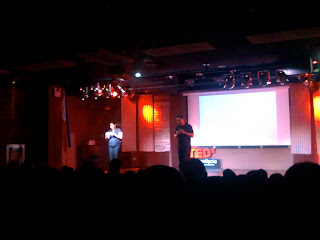why not?: notes on tedx fort bonifacio
Yesterday's TEDx at Fort Bonifacio was, in keeping with TED tradition, a celebration of ideas. Not of the abstract kind, but of the practical kind. Ideas that inspire, challenge, and make one think.
First off, Ana Arce posed a challenge: make the world a little more Deaf-(with a capital "D" as opposed to "deaf") friendly. Have closed captioning and subtitles in movies. Or better yet, have sign language interpreters. For more about Ana's talk, read this.
Dr. Lourdes Cruz, who has worked extensively with the Ayta community in Morong, Bataan, presented the 4-helix model for S&T-based economic development. It's a mouthful, but it basically means giving the community a say in their development. It's a doable alternative to the usual development model, which relies on a 3-way interface between government, the academe, and business.
The inventions of the prolific Dr. David Manalo were actually very simple solutions to common and simple problems. As he said in this talk, "Why complicate the solution when the problem is simple?" His inventions had been awarded grants from the World Bank, no less. An audience favorite was the carabao decoy: kept outside the house, mosquitoes are supposed to flock to it, effectively sparing the people inside the house from mosquito bites. A simple solution, indeed -- but no awards or grants for that one.
Young photojournalist VJ Villafranca showed the audience a different way of seeing the world -- through the lens of a digital camera. From this vantage point, he explored the grit and grime of BASECO, an urban poor community in Manila. Each photo is a story in black and white, framed in stark contrast and harsh reality.
The husband-and-wife team of Drs. Chris and Marivic Bernido ended TEDx with a presentation on the sorry state of science education in the country -- and what they have done to turn it around. The figures are certainly impressive: 1% of high school seniors performing excellently in the sciences, and higher percentages getting average and above-average scores. At an estimated 700,000 high school seniors, 1% is 7,000 students. Wow. TEDx organizer Gene Battung introduces the next speaker while Veronica Perez, dean of the De La Salle-College of Saint Benilde School of Deaf Education and Applied Studies, signs for the Deaf community.
TEDx organizer Gene Battung introduces the next speaker while Veronica Perez, dean of the De La Salle-College of Saint Benilde School of Deaf Education and Applied Studies, signs for the Deaf community.
In the end, what defined my TEDx experience was the fact that the ideas presented in the talks entered not only the broad realm of possibility, but more importantly, of doability.
So why not have more sign language interpreters? Why not involve communities in rural development? Why not use water to generate electricity for communities in the mountains? Why not use photos to tell stories and document life? Why not improve students' performance in the sciences? It's possible after all. So why not?
+++
I'm a TED fan, so it was only natural that, when I heard about TEDx happening at the Fort, I wanted to go.
But just to be clear, this wasn't the first TEDx talk in Manila. And hopefully not the last.
